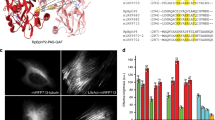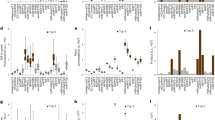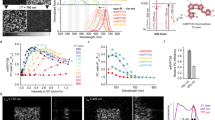Abstract
Near-infrared fluorescent proteins (FPs) are in high demand for in vivo imaging. We developed four spectrally distinct near-infrared FPs—iRFP670, iRFP682, iRFP702 and iRFP720—from bacterial phytochromes. iRFPs exhibit high brightness in mammalian cells and tissues and are suitable for long-term studies. iRFP670 and iRFP720 enable two-color imaging with standard approaches in living cells and mice. The four new iRFPs and the previously engineered iRFP713 allow multicolor imaging with spectral unmixing in living mice.
This is a preview of subscription content, access via your institution
Access options
Subscribe to this journal
Receive 12 print issues and online access
$259.00 per year
only $21.58 per issue
Buy this article
- Purchase on Springer Link
- Instant access to full article PDF
Prices may be subject to local taxes which are calculated during checkout


Similar content being viewed by others
References
Weissleder, R. Nat. Biotechnol. 19, 316–317 (2001).
Strack, R.L. et al. Biochemistry 48, 8279–8281 (2009).
Lin, M.Z. et al. Chem. Biol. 16, 1169–1179 (2009).
Morozova, K.S. et al. Biophys. J. 99, L13–L15 (2010).
Shcherbo, D. et al. Nat. Methods 7, 827–829 (2010).
Subach, O.M. et al. Nat. Methods 8, 771–777 (2011).
Piatkevich, K.D., Subach, F.V. & Verkhusha, V.V. Chem. Soc. Rev. 42, 3441–3452 (2013).
Giraud, E. & Vermeglio, A. Photosynth. Res. 97, 141–153 (2008).
Auldridge, M.E. & Forest, K.T. Crit. Rev. Biochem. Mol. Biol. 46, 67–88 (2011).
Giraud, E. et al. J. Biol. Chem. 280, 32389–32397 (2005).
Shu, X. et al. Science 324, 804–807 (2009).
Auldridge, M.E., Satyshur, K.A., Anstrom, D.M. & Forest, K.T. J. Biol. Chem. 287, 7000–7009 (2012).
Filonov, G.S. et al. Nat. Biotechnol. 29, 757–761 (2011).
Filonov, G.S. et al. Angew. Chem. Int. Edn. Engl. 51, 1448–1451 (2012).
Wagner, J.R., Brunzelle, J.S., Forest, K.T. & Vierstra, R.D. Nature 438, 325–331 (2005).
Toh, K.C., Stojkovic, E.A., van Stokkum, I.H., Moffat, K. & Kennis, J.T. Phys. Chem. Chem. Phys. 13, 11985–11997 (2011).
Strack, R.L. et al. Nat. Methods 5, 955–957 (2008).
Ho, S.N., Hunt, H.D., Horton, R.M., Pullen, J.K. & Pease, L.R. Gene 77, 51–59 (1989).
Wegerer, A., Sun, T. & Altenbuchner, J. BMC Biotechnol. 8, 2 (2008).
Giraud, E. et al. Photochem. Photobiol. Sci. 3, 587–591 (2004).
Kremers, G.J., Goedhart, J., van den Heuvel, D.J., Gerritsen, H.C. & Gadella, T.W. Jr. Biochemistry 46, 3775–3783 (2007).
Subach, O.M. et al. Chem. Biol. 15, 1116–1124 (2008).
Waddington, S.N. et al. Cell 132, 397–409 (2008).
Acknowledgements
We thank E. Giraud (Institute for Research and Development, France) for the hmuO and RpBphP6 genes, F. Subach (currently at the National Research Center “Kurchatov Institute”) for the pWA23h plasmid, G. Filonov (currently at Weill Cornell Medical College) for the iRFP713 adenovirus, J. Zhang for assistance in cell sorting, Y. Wang, L.-M. Ting, X. Wang and K. Piatkevich for help with mouse experiments, B. Taylor (PerkinElmer/Caliper) for assistance with the Living Image software and P. Guo for help with the confocal microscope. This work was supported by grants GM073913, CA164468 and EB013571 from the US National Institutes of Health.
Author information
Authors and Affiliations
Contributions
D.M.S. developed the proteins and characterized them in vitro, in cultured cells and in mice. V.V.V. directed and planned the project. V.V.V. and D.M.S. designed the experiments, analyzed the data and wrote the manuscript.
Corresponding author
Ethics declarations
Competing interests
The authors declare no competing financial interests.
Supplementary information
Combined PDF
Supplementary Figures 1–13 (PDF 6005 kb)
Rights and permissions
About this article
Cite this article
Shcherbakova, D., Verkhusha, V. Near-infrared fluorescent proteins for multicolor in vivo imaging. Nat Methods 10, 751–754 (2013). https://doi.org/10.1038/nmeth.2521
Received:
Accepted:
Published:
Issue Date:
DOI: https://doi.org/10.1038/nmeth.2521
This article is cited by
-
Relatively Rare Populations of Invasive Cells Drive Progression of Heterogeneous Tumors
Cellular and Molecular Bioengineering (2024)
-
Blue-shift photoconversion of near-infrared fluorescent proteins for labeling and tracking in living cells and organisms
Nature Communications (2023)
-
Design of a palette of SNAP-tag mimics of fluorescent proteins and their use as cell reporters
Cell Discovery (2023)
-
Disruption of ER ion homeostasis maintained by an ER anion channel CLCC1 contributes to ALS-like pathologies
Cell Research (2023)
-
Quantitative assessment of near-infrared fluorescent proteins
Nature Methods (2023)



